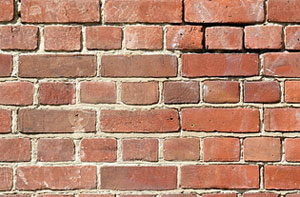Repointing
Brick Pointing and Repointing
Brick repointing, also known as tuckpointing, is a crucial restoration technique employed to maintain the structural integrity and aesthetic appeal of brick buildings. Brickwork, while durable and charming, is susceptible to erosion over time, specifically in the mortar joints that bind the bricks together. This erosion can be accelerated due to various factors such as moisture, temperature fluctuations, and air pollution. Repointing is the process of renewing these weathered or damaged joints to preserve the lifespan of the brickwork and ensure the building's continued stability.
Repointing is a meticulous process that requires specialized skills and knowledge. Before the repointing begins, the current condition of the mortar joints is thoroughly assessed to determine the extent of the damage. The depth of the eroded or damaged mortar must be measured; generally, when it has receded 6mm or more, repointing is recommended.
Once the need for repointing is established, the old mortar is carefully removed to a certain depth using a grinder or a chisel, ensuring not to damage the bricks. This step, known as raking out, is critical and requires a gentle, deliberate approach. Hastily or forcefully removing mortar can cause unnecessary damage to the bricks, which can in turn compromise the structure.
Next, the correct type of mortar must be prepared for the repointing process. It's crucial that the new mortar matches the composition, color, and texture of the existing one as closely as possible. This helps in maintaining the original aesthetic of the brickwork and ensures that the new mortar performs similarly to the old under weathering conditions.

The process of actually repointing the brickwork involves filling the raked out joints with the fresh mortar. This is typically done using a pointing trowel, ensuring the new mortar is compacted tightly into the joints to prevent future water penetration. After this, the mortar is tooled, or shaped, to match the original style of the joints.
The final step is to let the mortar cure properly. While it may seem dry and set after a few hours, mortar usually needs several days or even weeks to fully cure, depending on the weather conditions.
In conclusion, brick repointing is a delicate process requiring an understanding of the materials involved and careful workmanship. It's often a wise investment, as it can significantly extend the life of a brick building and maintain its historical and architectural value.
Does Repointing Stop Damp?
Repointing can help to prevent damp in certain cases. If the source of the damp is due to failed or degraded mortar joints that are allowing water to penetrate into the brickwork, then yes, repointing would resolve this issue by renewing the mortar and creating a solid, weather-resistant barrier.
However, it's important to note that damp can be caused by various issues, not just failing mortar joints. These can include rising damp (moisture rising from the ground), penetrating damp (water leaking through walls), condensation, and plumbing leaks, among others. Repointing will not help if the damp is due to one of these other issues.
Therefore, if you're dealing with damp in your property, it's crucial to correctly identify the cause before undertaking any repair work. A professional surveyor or builder can help determine the cause of the damp and suggest the most appropriate solution. If the cause is deteriorated mortar, then a professional repointing job could indeed solve the problem.
Also find repointing in Grange-over-Sands, repointing in Broughton Astley, repointing in How Wood, repointing in Gatley, repointing in Ash, repointing in Frome, repointing in Sandhurst, repointing in Eltham, repointing in Chigwell, repointing in Llantwit Major, repointing in Stone, repointing in Knutsford, repointing in Billing, repointing in Bridgend, repointing in Carmarthen, repointing in Lostwithiel, repointing in Wells, repointing in Wincanton, repointing in Staplehurst, repointing in Wilmslow, repointing in Church, repointing in Liskeard, repointing in Ambleside, repointing in Middleton Cheney, repointing in Enniskillen, repointing in Bradford-on-Avon, repointing in Flint, repointing in Tilehurst, repointing in Putney, repointing in Tewkesbury, repointing in Winscombe, repointing in Clapham, repointing in Calverton, repointing in Dalgety Bay, repointing in Towcester, repointing in Ore, repointing in Burnham-on-Crouch, repointing in Bishop's Cleeve, repointing in St Ives, repointing in Higham Ferrers, repointing in Hatfield, repointing in Honiton, repointing in Cranleigh, repointing in Oldham, repointing in Snodland, repointing in Chatteris, repointing in Dunblane, repointing in North Hykeham, repointing in Carnoustie, repointing in Chertsey, repointing in Dagenham.
Some of Our Repointing Pages:
https://www.repointings.uk/clapham.html
https://www.repointings.uk/frome.html
https://www.repointings.uk/oldham.html
https://www.repointings.uk/hatfield.html
https://www.repointings.uk/towcester.html
https://www.repointings.uk/wilmslow.html
https://www.repointings.uk/putney.html
https://www.repointings.uk/llantwit-major.html
https://www.repointings.uk/liskeard.html
https://www.repointings.uk/burnham-on-crouch.html
https://www.repointings.uk/wells.html
https://www.repointings.uk/broughton-astley.html
https://www.repointings.uk/ash.html
https://www.repointings.uk/knutsford.html
https://www.repointings.uk/middleton-cheney.html
https://www.repointings.uk/north-hykeham.html
https://www.repointings.uk/eltham.html
https://www.repointings.uk/tilehurst.html
https://www.repointings.uk/sandhurst.html
https://www.repointings.uk/winscombe.html
https://www.repointings.uk/chertsey.html
https://www.repointings.uk/wincanton.html
https://www.repointings.uk/higham-ferrers.html
https://www.repointings.uk/bridgend.html
https://www.repointings.uk/bishops-cleeve.html
https://www.repointings.uk/ore.html
https://www.repointings.uk/billing.html
https://www.repointings.uk/calverton.html
https://www.repointings.uk/ambleside.html
https://www.repointings.uk/enniskillen.html
https://www.repointings.uk/carmarthen.html
https://www.repointings.uk/carnoustie.html
https://www.repointings.uk/church.html
https://www.repointings.uk/honiton.html
https://www.repointings.uk/grange-over-sands.html
https://www.repointings.uk/dunblane.html
https://www.repointings.uk/lostwithiel.html
https://www.repointings.uk/tewkesbury.html
https://www.repointings.uk/how-wood.html
https://www.repointings.uk/gatley.html
https://www.repointings.uk/st-ives.html
https://www.repointings.uk/chatteris.html
https://www.repointings.uk/stone.html
https://www.repointings.uk/cranleigh.html
https://www.repointings.uk/flint.html
https://www.repointings.uk/bradford-on-avon.html
https://www.repointings.uk/snodland.html
https://www.repointings.uk/staplehurst.html
https://www.repointings.uk/chigwell.html
You can also find repointing experts in these UK places: Wootton Bridge, Cheadle, Market Bosworth, Wyberton, Polesworth, South Benfleet, Dalry, Larkhall, Locks Heath, Felpham, Great Missenden, Chipping Campden, Mountain Ash, Abertillery, Witley, Great Lumley, Carluke, Lindfield, Ibstock, Easington, Fowey, Bexley, Burslem, Conisbrough, Strood, Peebles, Dawlish, Buntingford, Grappenhall, Brampton, Sutton, Durham, Hindley, Coseley, Bude, Bulwell, Martock, Cromer, Skelton, Hereford, Southwell, North Petherton, Tadcaster, Penge, Southend-on-Sea, Netherfield, Omagh, Leigh, Hamilton, Brightlingsea, Woodley, Coventry.
Chimney Repointing: Keeping Your Chimney in Top Condition
Chimneys are a defining feature of many UK homes, adding character and charm to both period properties and modern houses. However, they're also exposed to the elements all year round, which can take a toll on their condition over time. Repointing your chimney is an essential maintenance task that helps to keep it safe, functional, and looking its best. It involves renewing the mortar between the bricks, which can deteriorate due to weathering, age, or general wear and tear.
The main purpose of chimney repointing is to restore the structural integrity of the chimney. Crumbling mortar not only weakens the structure but can also allow water to seep in, leading to damp problems and further damage. Left unchecked, these issues can escalate, potentially resulting in costly repairs. Repointing ensures the chimney remains secure and prevents problems like bricks becoming loose or the chimney leaning.
Repointing isn't just about functionality - it also improves the appearance of your chimney. A well-maintained chimney enhances your home's kerb appeal, especially if it's a prominent feature of the roofline. Matching the new mortar to the original colour and texture is crucial for maintaining the aesthetic of the property, particularly for older or listed buildings where period features are important.
The process of chimney repointing is best left to professionals, as it requires specialist tools, skills, and knowledge. Working at height can be dangerous, and ensuring the mortar is applied correctly and evenly is essential for a durable and visually appealing finish. A professional will also check for other issues, such as cracks or damage to the chimney pot, addressing any additional concerns during the process.
In summary, chimney repointing is a worthwhile investment that protects both the structure and appearance of your chimney. It not only prevents costly repairs down the line but also keeps your home looking its best. By hiring an experienced tradesperson, you can ensure the job is done to a high standard, giving you peace of mind that your chimney is in safe hands.
Get chimney repointing and other repointing services in these UK areas: Bovingdon, Eton, Milton Keynes, Camelford, Caerphilly, Spalding, Newmarket, Aylesford, Middleton-on-Sea, Saltdean, East Wittering, Moor Park, Bedford, Thetford, Hornchurch, Saffron Walden, Willaston, Melksham, Litherland, Liskeard, Failsworth, Kirkcaldy, Holmfirth, Wells-next-the-Sea, Gorseinon, Selston, Chelsea, Hoddesdon, Bebington, Manchester, Teddington, Wilmslow, Ash, Dalkeith, Beckenham, Barton-under-Needwood, Banstead, Sandhurst, Grimethorpe, Bridgnorth, Frimley, Blackwater, Wilmington, Grange-over-Sands, Moreton-in-Marsh, Epping, Ruskington, Peasedown St John, Weybridge, Hadlow.
More: Brickwork Sealing, Chimney Repointing, House Repointing, Pointing, Brick Repointing, Roof Repointing, Chimney Repointing, Brickwork Cleaning, Brickwork Cleaning, Patio Repointing, Brick Pointing, Patio Repointing, Slab Repointing, Repointing, Mortar Raking, Mortar Raking, Brick Repointing, Slab Repointing, Brickwork Sealing, Brickwork Repointing, Patio Repointing, Repointing, Bricklayers, Slab Repointing, Repointing, Patio Repointing, Bricklayers, Wall Repointing, Brick Cleaning, Slab Repointing, Brickwork Sealing, Roof Repointing, Repointing, Slab Repointing, Pointing, Mortar Raking, Repointing Specialists, Brickwork Repointing, Mortar Repointing, Roof Repointing, Bricklayers, Repointing Specialists, Repointing Specialists, Repointing, Roof Repointing, Brick Pointing, Wall Repointing, Roof Repointing, Brick Pointing, Brickwork Sealing.


